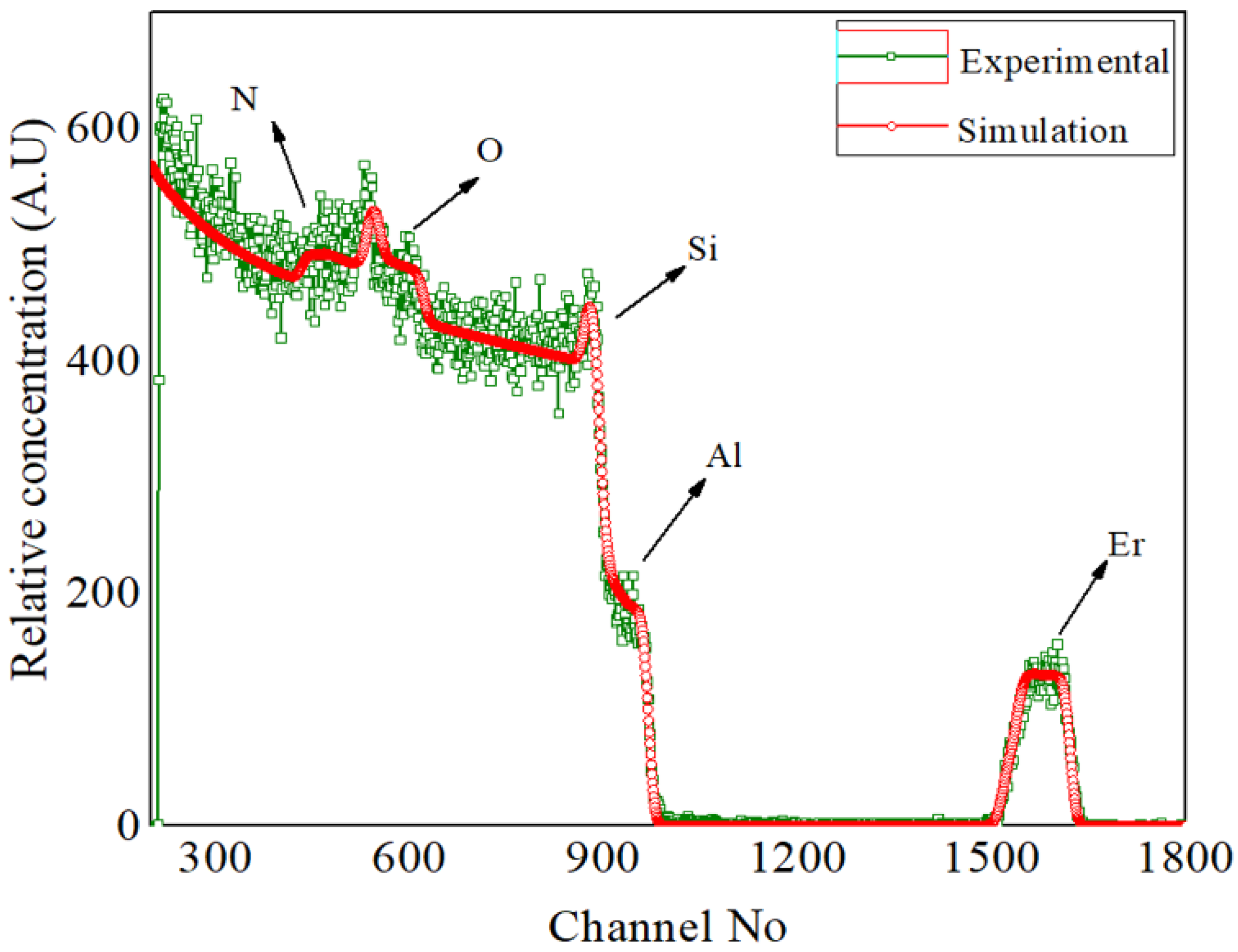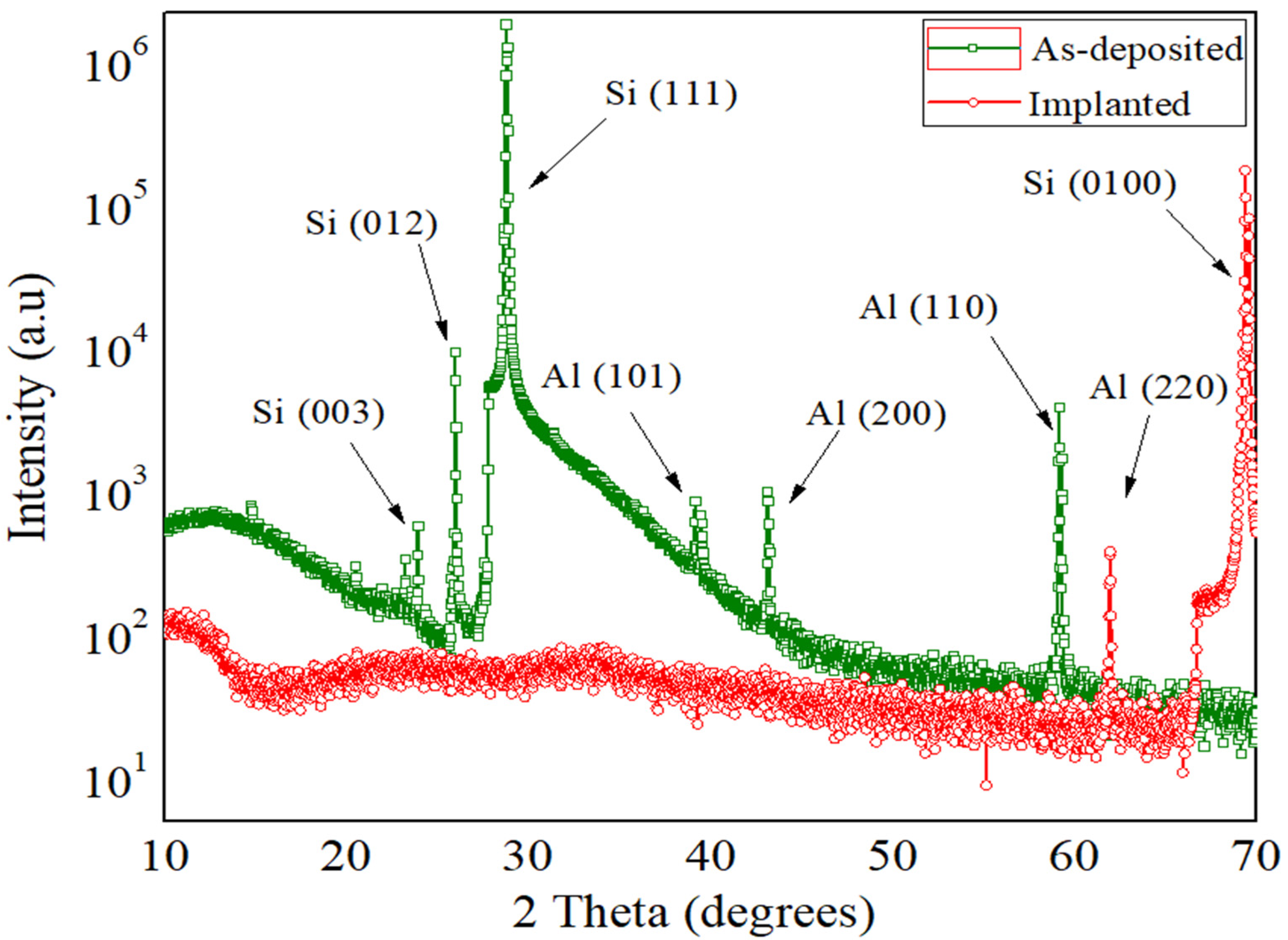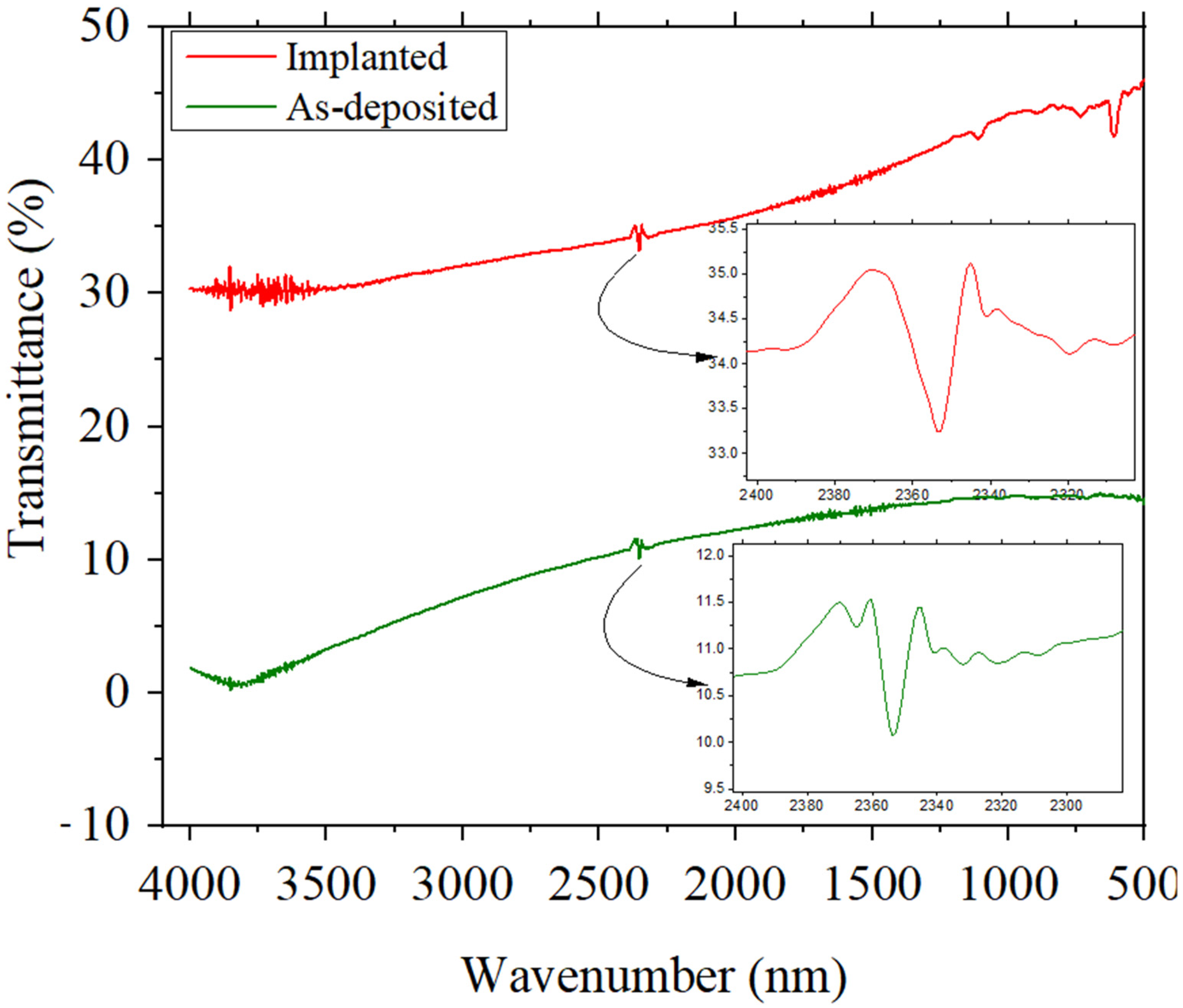Ion Beam Effect on the Structural and Optical Properties of AlN:Er
Abstract
:1. Introduction
2. Materials and Methods
2.1. Thin Film Deposition
2.2. Thin Film Characterizations
3. Results
4. Conclusions
Author Contributions
Funding
Institutional Review Board Statement
Informed Consent Statement
Data Availability Statement
Conflicts of Interest
References
- Subramani, S.; Mutharasu, M. Influence of AlN Thin Film as Thermal Interface Material on Therminfal and Optical Properties of High-Power LED. IEEE Trans. Device Mater. Reliab. 2014, 14, 30–34. [Google Scholar] [CrossRef]
- Ponce, F.A.; Bour, D.P. Nitride-based semiconductors for blue and green light-emitting devices. Nature 1997, 386, 351–359. [Google Scholar] [CrossRef]
- Ullah, A.; Usman, M.; Qingyu, W.; Ahmad, I.; Khosa, R.Y.; Maqbool, M. Response of structural and optical properties against proton irradiation in AlN:Tm thin films. Radiat. Phys. Chem. 2021, 180, 109234. [Google Scholar] [CrossRef]
- Alsaad, A.M.; Al-Bataineh, Q.M.; Qattan, I.A.; Ahmad1, A.A.; Ababneh, A.; Albataineh, Z.; Aljarrah, I.A.; Telfah, A. Measurement and ab initio Investigation of Structural, Electronic, Optical, and Mechanical Properties of Sputtered Aluminum Nitride Thin Films. Front. Phys. 2020, 8, 115. [Google Scholar] [CrossRef]
- Mendez, M.G.; Rodrıguez, S.M.; Machorro, R.; de la Cruz, W. Characterization of ALN thin films deposited by DC reactive magnetron sputtering. Rev. Mex. Fis. 2008, 54, 271–278. [Google Scholar]
- Vaskin, A.; Kolkowski, R.; Koenderink, A.F.; Staude, I. Light-Emitting Metasurfaces: Simultaneous Control of Spontaneous Emission and Far-Field Radiation. Nanophotonics 2019, 8, 1151–1198. [Google Scholar] [CrossRef]
- Cheng, Z.; Koh, Y.R.; Mamun, A.; Shi, J.; Bai, T.; Huynh, K.; Yates, L.; Liu, Z.; Li, R.; Lee, E.; et al. Experimental observation of high intrinsic thermal conductivity of AlN. Phys. Rev. Mater. 2020, 4, 044602. [Google Scholar] [CrossRef]
- Ullah, A.; Usman, M.; Qingyu, W.; Ahmad, I.; Maqbool, M. Fabrication and ions irradiation study of AlN:Gd thin films ECS. J. Solid State Sci. Technol. 2022. [Google Scholar] [CrossRef]
- Liu, Y.; Lu, Q.; Lin, G.; Liu, J.; Lu, S.; Tang, Z.; He, H.; Fu, Y.; Shen, X. Effect of thermal annealing on properties of amorphous GaN/p-Si heterojunctions. Mater. Res. Express 2019, 6, 085904. [Google Scholar] [CrossRef]
- Zan, H.-W.; Chou, C.-W.; Wang, C.-H.; Song, H.-T.; Hwang, J.-C.; Lee, P.-T. Carbon attachment on the aluminum nitride gate dielectric in the pentacene-based organic thin-film transistors. J. Appl. Phys. 2009, 105, 063718. [Google Scholar] [CrossRef] [Green Version]
- Fang, L.; Yin, A.; Zhu, S.; Ding, J.; Chen, L.; Zhang, D.; Pu, Z.; Liu, T. On the potential of Er-doped AlN film as a luminescence sensing layer for multilayer Al/AlN coating health monitoring. J. Alloys Compd. 2017, 8, 174. [Google Scholar] [CrossRef]
- Favennec, P.N.; Haridon, H.L.; Salvi, M.; Moutonnet, D.; Guillou, Y.L. Electrical, optical, and magnetic properties of Erbium. Elect. Lett. 1989, 25, 718. [Google Scholar] [CrossRef]
- Wu, X.; Hmmerich, U.; MacKenzie, J.D.; Abernathy, C.R.; Pearton, S.J.; Wilson, R.G.; Schwartz, R.N.; Zavada, J.M. Photoluminescence study of Er-doped AlN. J. Lumin. 1997, 72–74, 284–286. [Google Scholar] [CrossRef]
- Hassan, N.; Hussain, Z.; Naeem, M.; Shah, I.A.; Husnain, G.; Ahmad, I.; Ullah, Z. Influence of Ion Beam Irradiation on Structural, Magnetic and Electrical Characteristics of Ho-doped AlN Thin Films. Surf. Rev. Lett. 2016, 10, 1142. [Google Scholar] [CrossRef]
- Ullah, A.; Wang, Q.; Ahmad, I.; Usman, M. Irradiation effects on Nd and W doped Aluminum Nitride thin films. Phys. B Cond. Mat. 2020, 586, 412086. [Google Scholar] [CrossRef]
- Usman, M.; Hallén, A.; Nazir, A. Ion implantation induced nitrogen defects in GaN. J. Phys. D Appl. Phys. 2015, 48, 45510. [Google Scholar] [CrossRef]
- Summers, G.P.; Burke, E.A.; Shapiro, P.; Messenger, S.R.; Walters, R.J. Damage Co-relations in semiconductors exposed to gamma, electron and proton radiation. IEEE Trans. Nucl. Sci. 1993, 40, 6–14. [Google Scholar] [CrossRef] [Green Version]
- Khan, S.; Husnain, G.; Ahmad, I.; Khan, K.; Usman, M.; Riaz, S. Structural characteristics of Ni+-implanted AlN thin film. Surf. Topogr. Metrol. Prop. 2014, 2, 035007. [Google Scholar] [CrossRef]
- Maqbool, M.; Wilson, E.; Clark, J.; Ahmad, I.; Kayani, A. Luminescence from Crþ3-doped AlN films deposited on optical fiber and silicon substrates for use as waveguides and laser cavities. Appl. Opt. 2010, 49, 4. [Google Scholar] [CrossRef]
- Maqbool, M.; Corn, T.R. Optical spectroscopy and energy transfer in amorphous AlN-doped erbium and ytterbium ions for applications in laser cavities. Opt. Lett. 2010, 35, 18. [Google Scholar] [CrossRef]
- SIMNRA Ver. 6.06. Available online: http://home.rzg.mpg.de/~mam/ (accessed on 21 February 2022).
- Starikov, S.V.; Kolotova, L.N.; Kuksin, A.Y.; Smirnova, D.E.; Tseplyaev, V.I. Atomistic simulation of cubic and tetragonal phases of U-Mo alloy: Structure and thermodynamic properties. J. Nucl. Mater. 2018, 499, 451–463. [Google Scholar] [CrossRef]
- Tian, X.-F.; Xiao, H.-X.; Tang, R.; Lu, C.-H. Molecular dynamics simulation of displacement cascades in U–Mo alloys. Nucl. Instrum. Methods Phys. Res. B 2014, 321, 24–29. [Google Scholar] [CrossRef]
- Callister, W.D., Jr. Material Science and Engineering: An Introduction, 7th ed.; Wiley: New York, NY, USA, 2018. [Google Scholar]
- Gil, B. Group III Nitride Semiconductor Compounds Physics and Application; Clarendon Press: Oxford, UK; London, UK, 1998. [Google Scholar]
- TiJeon, D.W.; Sun, Z.; Li, J.; Lin, J.; Jiang, H. Erbium doped GaN synthesized by hydride vapor-phase epitaxy. Opt. Mater. Express 2015, 5, 596–602. [Google Scholar]
- Zhang, H.Z.; Wang, R.M.; You, L.P.; Yu, J.; Chen, H.; Yu, D.P.; Chen, Y. Boron carbide nanowires with uniform CNx coatings. New J. Phys. 2007, 9, 13. [Google Scholar] [CrossRef]
- Khan, M.N.; Khan, M.A.M.; Al Dwayyan, A.S.; Labis, J.P. Comparative Study on Electronic, Emission, Spontaneous Property of Porous Silicon indifferent solvents. J. Nanomater. 2010, 14, 682571. [Google Scholar]
- Panda, P.; Mantry, S.; Mohapatra, S.; Singh, S.K.; Satapathy, A. A study on erosive wear analysis of glass fiber–epoxy–AlN hybrid composites. J. Compos. Mater. 2012, 5, 789. [Google Scholar] [CrossRef]
- Martin, F.; Muralt, P. Thickness dependence of the properties of highly c-axis texturedAlN thin films. J. Vac. Sci. Technol. A 2004, 22, 361. [Google Scholar] [CrossRef]
- Pandya, S.G.; Corbett, J.P.; Jadwisienczak, W.M.; Kordesch, M.E. Structural characterization and X-ray analysis by Williamson-Hall method for Erbium doped Aluminum Nitride nanoparticles, synthesized using inert gas condensation technique. Phys. E Low-Dimens. Syst. Nanostruct. 2016, 79, 98–102. [Google Scholar] [CrossRef]
- Balasubramanian, C.; Bellucci, S.; Cinque, G.; Marcelli, A.; Guidi, M.C.; Piccinini, M.; Popov, A.; Soldatov, A.; Onorato, P. Characterization of aluminum nitride nanostructures by XANES and FTIR spectroscopies with synchrotron radiation. J. Phys. Condens. Matter 2006, 18, 2095–2104. [Google Scholar] [CrossRef]
- Angappana, S.; Jeneafer, R.A.; Visuvasama, A.; Berchmans, L.J. Synthesis of AlN presence and absence of additive. Est. J. Eng. 2013, 19, 239–249. [Google Scholar] [CrossRef] [Green Version]
- Seki, K.; Xu, X.; Okabe, H.; Frye, J.M.; Halpern, J.B. Room-temperature growth of AlN thin films” by laser ablation. Appl. Phys. Lett. 1992, 60, 2234–2236. [Google Scholar] [CrossRef]




| Sample | Al (%) | N (%) | O (%) | Er | Thickness |
|---|---|---|---|---|---|
| AlN:Er | 43.0 | 35.1 | 20.5 | 1.4 | 160 nm |
Publisher’s Note: MDPI stays neutral with regard to jurisdictional claims in published maps and institutional affiliations. |
© 2022 by the authors. Licensee MDPI, Basel, Switzerland. This article is an open access article distributed under the terms and conditions of the Creative Commons Attribution (CC BY) license (https://creativecommons.org/licenses/by/4.0/).
Share and Cite
Ullah, A.; Usman, M.; Shah, A.H.; Shar, A.H.; Maqbool, M. Ion Beam Effect on the Structural and Optical Properties of AlN:Er. J. Compos. Sci. 2022, 6, 110. https://doi.org/10.3390/jcs6040110
Ullah A, Usman M, Shah AH, Shar AH, Maqbool M. Ion Beam Effect on the Structural and Optical Properties of AlN:Er. Journal of Composites Science. 2022; 6(4):110. https://doi.org/10.3390/jcs6040110
Chicago/Turabian StyleUllah, Asmat, Muhammad Usman, Ahmer Hussain Shah, Altaf Hussain Shar, and Muhammad Maqbool. 2022. "Ion Beam Effect on the Structural and Optical Properties of AlN:Er" Journal of Composites Science 6, no. 4: 110. https://doi.org/10.3390/jcs6040110
APA StyleUllah, A., Usman, M., Shah, A. H., Shar, A. H., & Maqbool, M. (2022). Ion Beam Effect on the Structural and Optical Properties of AlN:Er. Journal of Composites Science, 6(4), 110. https://doi.org/10.3390/jcs6040110







